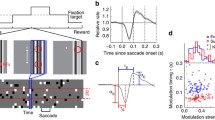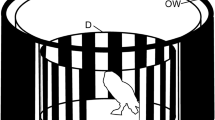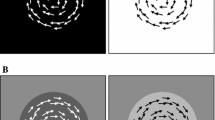Summary
-
1.
Neuronal classes. Recordings from single optic nerve fibers of the common toad Bufo bufo (L.) have revealed three types of retinal ganglion cells which correspond to classes II, III and IV in the frog.
-
2.
Receptive field organization. All neurones have a central excitatory field, ERF, surrounded by an inhibitory one, IRF (Fig. 10a, b). The ERF for each cell class was ERFII ≈ 4°, ERFIII ≈ 8°, ERFIV = 12–15°.
-
3.
Illuminance change over the entire visual field had no effect on class II neurones, produced an “on — off” response in class III and an “off” response in class IV (Fig. 2b–c).
-
4.
Angular size of stimuli moved through the central rezeptive field (constant angular velocity and stimulus background contrast). (i) Squares: As the edge length approached the ERF diameter, the discharge rate of all neurones increased, then decreased for larger squares which activated the inhibitory surround (Figs. 3, 4a). (ii) Extending a vertical stripe in the horizontal direction of movement had a similar effect (Fig. 4b). (iii) Elongating a horizontal stripe by more than 2° in the direction of movement produced no change in the discharge rate (Fig. 4c). (iv) Simultaneous movement of two stimuli a and b through the ERF caused a greater discharge than for either allone. Responses to a in the ERF were inhibited if b was in the IRF (Fig. 5).
-
5.
Increased angular velocity (constant contrast and angular size) produced increased activation of all neurones (Fig. 6a–d). The degree of increase was different in each neuronal class (Fig. 7A).
-
6.
Stimulus background contrast (constant angular size and velocity). The discharge rate generally increased for increasing contrast between stimulus and background (Fig. 8). A white stimulus against black background produced maximal activation of class II neurones; black on white was maximally effective for the other two classes (Fig. 9a–c).
-
7.
Input-output functions. A power function best describes the relationships between impulse frequency and (i) stimulus angular velocity, and (ii) stimulus background contrast (Eqs. 9, 11). Impulse frequency is logarithmically dependent on stimulus area (Eqs. 3–6).
-
8.
Retinal output and visual behaviour. The neurophysiological findings are compared with quantitative results previously obtained from corresponding behavioural experiments concerning visually induced prey-catching and avoidance reactions.
Similar content being viewed by others
References
Butenandt, E., Grüsser, O.-J.: The effect of stimulus area on the response of movement detecting neurons in the frog's retina. Pflügers Arch. ges. Physiol. 298, 238–293 (1968).
Ewert, J.-P.: Elektrische Reizung des retinalen Projektionsfeldes im Mittelhirn der Erdkröte (Bufo bufo L.). Pflügers Arch. ges. Physiol. 295, 90–98 (1967).
—: Der Einfluß von Zwischenhirndefekten auf die Visuomotorik im Beute- und Flucht-verhalten der Erdkröte (Bufo bufo L.). Z. vergl. Physiol. 61, 41–70 (1968).
—: Quantitative Analyse von Reiz-Reaktionsbeziehungen bei visuellem Auslösen der Beute-fang-Wendereaktion der Erdkröte (Bufo bufo L.). Pflügers Arch. 308, 225–243 (1969).
—: Neural mechanisms of prey-catching and avoidance behavior in the toad (Bufo bufo L.). Brain Behav. Evol. 3, 36–56 (1970).
—: Single unit response of the toad's (Bufo americanus) caudal thalamus to visual objects. Z. vergl. Physiol. 74, 81–102 (1971).
—: Zentralnervöse Analyse und Verarbeitung visueller Sinnesreize. Naturwiss. Rdsch. 25, 1–11 (1972).
Ewert, J.-P., Borchers, H.-W.: Reaktionscharakteristik von Neuronen aus dem Tectum opticum und Subtectum der Erdkröte (Bufo bufo L.). Z. vergl. Physiol. 71, 165–189 (1971).
— Rehn, B.: Quantitative Analyse der Reiz-Reaktionsbeziehungen bei visuellem Auslösen des Fluchtverhaltens der Wechselkröte (Bufo viridis Laur.). Behaviour 35. 212–234 (1969).
— Speckhardt, I., Amelang, W.: Visuelle Inhibition und Excitation im Beutefangverhalten der Erdkröte Bufo bufo (L.). Z. vergl. Physiol. 68, 84–110 (1970).
Eysel, U.Th., Grüsser, O.-J.: Neurophysiological basis of pattern recognition in the cat's visual system. From: Pattern Recognition in Biological and Technical Systems. Ed. by O.-J. Grüsser and R. Klinke. Berlin-Heidelberg-New York: Springer 1971.
Fite, K.V.: Single unit analysis of binocular neurones in the frog optic tectum. Exp. Neurol. 24, 475–486 (1969).
Gaze, R.M.: The representation of the retina on the optic lobe of the frog. Quart. J. exp. Physiol. 43, 209–214 (1958).
Geestland, R.C., Howland, B., Lettvin, J.Y., Pitts, W.: Comments on microelectrodes. Proc. I. R. E. 47, 1856–1862 (1959).
Grüsser, O.-J., Dannenberg, H.: Eine Perimeter-Apparatur zur Reizung mit bewegten visuellen Mustern. Pflügers Arch. ges. Physiol. 285, 373–378 (1965).
—, Grüsser-Cornehls, U.: Die Informationsverarbeitung im visuellen System des Frosches. Kybernetik, 331–360. München: Oldenbourg 1968.
—: Neurophysiologie des Bewegungssehens. Ergebn. Physiol. 61, 178–265 (1969).
—: Die Neurophysiologie visuell gesteuerter Verhaltensweisen bei Anuren. Verh. dtsch. Zool. Ges. 64, 201–218 (1970).
— Finkelstein, D., Henn, V., Patutschnik, M., Butenandt, E.: A quantitative analysis of movement detecting neurones in the frog's retina. Pflügers Arch. ges. Physiol. 292, 100–106 (1967).
Ingle, D.: Visual releasers of prey-catching behavior in frogs and toads. Brain Behav. Evol. 1, 500–518 (1968).
Lettvin, J.Y., Maturana, H.R., McCulloch, W.S., Pitts, W.H.: What the frog's eye tells the frog's brain. Proc. Inst. Radio. Eng. 47, 1940–1945 (1959).
— Pitts, W.H., McCulloch, W.S.: Two remarks on the visual system of the frog. In: Sensory Communication. Ed. by W.A. Rosenblith, pp. 757–776. Cambridge, Mass.: M. I. T. Press (1961).
Maturana, H.R., Lettvin, J.Y., McCulloch, W.S., Pitts, W.H.: Anatomy and physiology of vision in the frog (Rana pipiens). J. gen. Physiol. 43, Suppl. 129–175 (1960).
Scalia, F., Knapp, H., Halpern, M., Riss, W.: New observations on the retinal projection in the frog. Brain Behav. Evol. 1, 324–353 (1968).
Author information
Authors and Affiliations
Additional information
This project was supported by grants of the Deutsche Forschungsgemeinschaft Ew 7/6 and SFB 45.
The work presented here was started together with Dr. Ursula Grüsser-Cornehls in the Department of Physiology, Free University Berlin and then continued systematically in Darmstadt.
Rights and permissions
About this article
Cite this article
Ewert, J.P., Hock, F. Movement-sensitive neurones in the toad's retina. Exp Brain Res. 16, 41–59 (1972). https://doi.org/10.1007/BF00233373
Received:
Issue Date:
DOI: https://doi.org/10.1007/BF00233373




